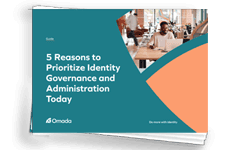Let's Get
Started
Let us show you how Omada can enable your business.
• Full-featured IGA
• Configurability without code
• Best-practice framework for solution design and deployment
• High degree of configurability
• Intelligent compliance
• Manage identities and access across hybrid platforms
• Support at every step of your IGA journey
• Personalized service package to accelerate your deployment
• Avoid common pitfalls and get value in 12 weeks
• Iterative implementation roadmap
• Standardized, well-documented best practices
• Support from Omada-certified project managers, architects, and consultants
• Stellar Customer Success Team
• Quick and professional Service Desk
• Access to ITSM system and KPI reports
• Digital self-paced and instructor-led courses
• Training on demand through our Premier Academy subscription
• Individual, role-based learning plans and certification paths
• Ensure fast and successful IGA deployment
• 5-step process with clear exit criteria
• 12 weeks time to value
• Helps support enterprise IT security
• Makes it easier to meet compliance mandates
• Automates access provisioning and enables the workforce from day 1
• Automated access provisioning and deprovisioning
• Least privilege and separation of duties policies
• Simple-to-run certification campaigns
• Access compliance status dashboards
• Cross-system certification campaigns
• 50+ audit report templates
• Identity lifecycle management
• Automatic access provisioning
• Self-service access requests
Omada provides Governance for Identity Fabric ensuring compliance regulations are met, security and efficiency around identity workflows are maintained.

A definite guide to Identity Governance and
Administration best practices. Learn how to
successfully deploy and maintain an IGA solution.

Our comprehensive Identity and Cybersecurity
glossary, featuring extensive explanations, real-life
examples, practical frameworks and everything else
you need to understand key concepts in identity and
cybersecurity.

In this Guide, Gartner has identified Omada as a
Representative Vendor in IGA. Use it to evaluate top
Identity Governance vendors and anticipate future
trends, features, and capabilities in the IGA market.

Familiarize yourself with the typical threats that
can derail a seamless legacy to cloud migration of
IGA functionality and get tips on managing them.

As part of their digital transformation, DEKRA moved
from an in-house access management solution to
a modern, cloud based Omada IGA solution.

Get practical examples and data proving the
value of IGA and learn the five key reasons you
must make it a business imperative today.

Explore our white papers on compliance, security, and
efficiency topics. Gain insights and best practices to drive
informed decisions and enhance your organizational strategy.

We are constantly adding new features to Omada
products to ensure your IGA efforts keep pace with
the ever-evolving threat landscape.

Get information about the newest Omada product
features, benefits, and use cases to ensure you get
the most from your IGA program.

Participate in interactive product demos covering
capabilities such as Delegate Access, Request
Access, Approve Access Request, and more.

Get the latest IGA trends, information, and intelligence
from renowned industry experts in Omada’s live and
on-demand webinar presentations.

A market-leading provider of identity governance
and administration solutions. Get to know us better!

At Omada, efficient teamwork creates extraordinary results.
We enable talented people to create career paths where
they can thrive, be inspired, and have fun.

Omada partners provide unmatched advisory, product
and service re-sale, and project delivery resulting in
unsurpassed customer satisfaction scores.

Don’t just take our word about the value of Omada
solutions. See what actual users think.

See what the media are reporting about our
innovative identity governance solutions.

We frequently deliver expert presentations, exhibit, and
run demos at the world’s leading security and IGA events.
Look at our upcoming schedule to see if we cross paths –
we'd love to speak with you.

Omada is a winner for a third consecutive year in the 7th
annual CyberSecurity Breakthrough Awards program.

Omada is a global market leader in Identity Governance.
Please reach out to us with questions or to get more information.

Find here legal documents governing and relating to the
provisioning of Omada Offerings - Customer Agreement, DPA, and more.
• Full-featured IGA
• Configurability without code
• Best-practice framework for solution design and deployment
• High degree of configurability
• Intelligent compliance
• Manage identities and access across hybrid platforms
• Support at every step of your IGA journey
• Personalized service package to accelerate your deployment
• Avoid common pitfalls and get value in 12 weeks
• Iterative implementation roadmap
• Standardized, well-documented best practices
• Support from Omada-certified project managers, architects, and consultants
• Stellar Customer Success Team
• Quick and professional Service Desk
• Access to ITSM system and KPI reports
• Digital self-paced and instructor-led courses
• Training on demand through our Premier Academy subscription
• Individual, role-based learning plans and certification paths
• Ensure fast and successful IGA deployment
• 5-step process with clear exit criteria
• 12 weeks time to value
• Helps support enterprise IT security
• Makes it easier to meet compliance mandates
• Automates access provisioning and enables the workforce from day 1
• Automated access provisioning and deprovisioning
• Least privilege and separation of duties policies
• Simple-to-run certification campaigns
• Access compliance status dashboards
• Cross-system certification campaigns
• 50+ audit report templates
• Identity lifecycle management
• Automatic access provisioning
• Self-service access requests
Omada provides Governance for Identity Fabric ensuring compliance regulations are met, security and efficiency around identity workflows are maintained.

A definite guide to Identity Governance and
Administration best practices. Learn how to
successfully deploy and maintain an IGA solution.

Our comprehensive Identity and Cybersecurity
glossary, featuring extensive explanations, real-life
examples, practical frameworks and everything else
you need to understand key concepts in identity and
cybersecurity.

In this Guide, Gartner has identified Omada as a
Representative Vendor in IGA. Use it to evaluate top
Identity Governance vendors and anticipate future
trends, features, and capabilities in the IGA market.

Familiarize yourself with the typical threats that
can derail a seamless legacy to cloud migration of
IGA functionality and get tips on managing them.

As part of their digital transformation, DEKRA moved
from an in-house access management solution to
a modern, cloud based Omada IGA solution.

Get practical examples and data proving the
value of IGA and learn the five key reasons you
must make it a business imperative today.

Explore our white papers on compliance, security, and
efficiency topics. Gain insights and best practices to drive
informed decisions and enhance your organizational strategy.

We are constantly adding new features to Omada
products to ensure your IGA efforts keep pace with
the ever-evolving threat landscape.

Get information about the newest Omada product
features, benefits, and use cases to ensure you get
the most from your IGA program.

Participate in interactive product demos covering
capabilities such as Delegate Access, Request
Access, Approve Access Request, and more.

Get the latest IGA trends, information, and intelligence
from renowned industry experts in Omada’s live and
on-demand webinar presentations.

A market-leading provider of identity governance
and administration solutions. Get to know us better!

At Omada, efficient teamwork creates extraordinary results.
We enable talented people to create career paths where
they can thrive, be inspired, and have fun.

Omada partners provide unmatched advisory, product
and service re-sale, and project delivery resulting in
unsurpassed customer satisfaction scores.

Don’t just take our word about the value of Omada
solutions. See what actual users think.

See what the media are reporting about our
innovative identity governance solutions.

We frequently deliver expert presentations, exhibit, and
run demos at the world’s leading security and IGA events.
Look at our upcoming schedule to see if we cross paths –
we'd love to speak with you.

Omada is a winner for a third consecutive year in the 7th
annual CyberSecurity Breakthrough Awards program.

Omada is a global market leader in Identity Governance.
Please reach out to us with questions or to get more information.

Find here legal documents governing and relating to the
provisioning of Omada Offerings - Customer Agreement, DPA, and more.
Home / What is Cloud Identity Management?


Cloud Identity Management is a system for managing user identities, access permissions, and authentication processes in cloud environments. It uses a centralized approach to manage user credentials, roles, and permissions so organizations can control and secure access to cloud-based applications, services, and resources.
Functionality that creates, updates, and removes user accounts across various cloud-hosted services. These tools automatically grant employees, contractors, partners, and vendors appropriate access to cloud-based systems, applications, and data during onboarding and revoke access to resources immediately when users’ roles change or for any reason no longer require it.
Enables users to log in once and access multiple cloud-hosted applications without requiring reauthentication. This reduces the need for users to create and manage passwords to gain access to every cloud-based resource and dramatically improves the quality of user experiences.
This functionality adds extra layers of security by requiring users to engage multiple verification methods to access cloud-based applications and resources. MFA uses passwords, biometric data, or authentication tokens to verify users’ identities across an organization’s IT infrastructure.
This enables administrators to control which users or groups can access specific cloud-hosted resources based on roles and policies while ensuring users have access rights sufficient to perform day-to-day responsibilities and at the same time do not violate organizational security policies and adhere to compliance regulations such as separation of duties (SoD).
Stores and organizes user identities across all cloud-based resources and provides authentication and authorization services for connected systems. Organizations frequently implement centralized databases such as LDAP and Active Directory to more effectively manage user identities in the cloud.
This is a method that enables organizations to integrate with external identity providers to provide user access across multiple cloud-based systems, services, or organizations using a single set of credentials. It allows different organizations or systems to establish trust relationships, enabling seamless cross-organization access without requiring users to maintain separate credentials for each system.
Tracks user activity and generates logs in cloud-based applications and resources to detect and respond to unusual or unauthorized access attempts and provide security analysis and ensure compliance with organizational policies and industry-specific regulations.
Cloud Identity Management ensures that employee, contractors, partners, and vendors user identities for cloud-based applications and resources are properly created, changed, and disabled when employees they join the organization, move departments, get promoted, and leave the organization. Strong authentication and centralized controls reduce unauthorized access risks and protect sensitive applications and data.
Automates identity-related tasks, such as Role-Based Access Control (RBAC) and Attribute-Based Access Control (ABAC), that predefine which systems a new user should have access to, based on their role in the organization. Automating access control enables administrators to immediately review access rights to cloud-based resources and ensure compliance with various regulations so that new users can be productive more quickly. This reduces the complexity of assigning user access rights to various cloud environments and reduces administrative overhead costs. A Cloud Identity Management system also scales to easily manage access for growing teams or organizations without adding costs.
Simplifies audits and helps meet regulatory requirements by managing and auditing access rights to sensitive information hosted in the cloud.
Features such as SSO and self-service portals eliminate the need for users to remember multiple credentials to access cloud-based resources and simplify the process.
Cloud Identity Management is an essential tool in a modern organizational Identity and Access Management (IAM) strategy. A SaaS-based Identity Governance and Administration (IGA) solution like Omada Identity Cloud enables organizations to implement a centralized approach to managing user credentials, roles, and permissions across all cloud-based environments. Omada Identity Cloud operates seamlessly with other IAM tools to streamline identity workflows, enhance security, and achieve compliance across on-premises, cloud-based, and hybrid IT architecture. Get a demo.



